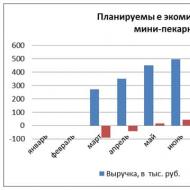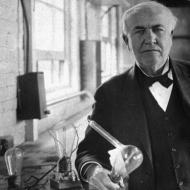
Rosatom (state corporation). Rosatom - latest news Rosatom will conduct research on Russian nuclear fuel materials in the Czech Republic
At the plenary meeting of the State Duma on June 26, the bill “On Amendments to the Federal Law “On Production and Consumption Waste” and the Federal Law “On the State Atomic Energy Corporation Rosatom” was adopted in the first reading
Personnel training at the Akkuyu NPP (Türkiye) has started at the Rosatom Technical Academy
At the beginning of July, training for personnel from the Akkuyu NPP (Turkey) began at the Rosatom Technical Academy. Within six months, the Academy will train over 70 Turkish nuclear specialists. Training for six NPP personnel training programs will be conducted in Russian
Rosatom 23 hours ago 5Rosatom will expand work with regions and industrial companies on lean technologies
The Rosatom State Corporation will expand its work with regions of the Russian Federation and Russian industrial companies, sharing its experience in implementing lean manufacturing technologies, General Director Go said at the Productivity 360 forum in Nizhny Novgorod
Rosatom 1 day ago 0Rosatom took part in the Baltic Digital Forum
On June 28 in St. Petersburg, the Director of the Information Technology Department (DIT) of the Rosatom State Corporation, Evgeny Abakumov, took part in the conference of representatives of Russian and international companies in the North-West region, Baltic Digital Forum. He is you
Rosatom 3 days ago 0Rosatom takes part in the educational program “Great Challenges” of the Talent and Success Foundation
On July 1, 2019, the scientific and technological educational program “Great Challenges” was launched at the Sirius educational center (Sochi). This is the largest project event of its kind for schoolchildren in Russia, aimed at the full development cycle
Rosatom 3 days ago 0As part of the Agreement between Rosatom and the Government of Udmurtia, 247 million rubles will be allocated for the socio-economic development of Glazov.
A list of measures for the socio-economic and infrastructural development of Glazov for 2019 has been determined, the implementation of which will unfold within the framework of the Agreement between the State Corporation Rosatom and the Government of the Udmurt Republic. Co-finance plan
Rosatom 3 days ago 0Rosatom will conduct research on Russian nuclear fuel materials in the Czech Republic
Rosatom fuel company TVEL and the Czech Research Center Řež (Centrum výzkumu Řež s.r.o., CVŘ) entered into an agreement on cooperation in the field of materials science research. As part of the agreement, Czech scientists will be able to conduct experiments
Rosatom 4 days ago 0Document. The resolution of the rally “Against the construction of a production and technical complex for the processing, disposal and disposal of waste of hazard class I and II on the basis of the Maradykovsky chemical weapons processing facility in the village. Peaceful
The head of Rosatom A. Likhachev took part in the opening ceremony of the Conformity Assessment Center and testing laboratory of the Rosatom Technical Academy
On June 26, 2019, General Director of the Rosatom State Corporation A. Likhachev took part in the opening ceremony of the Conformity Assessment Center and Testing Laboratory of the Rosatom Technical Academy. The ceremony was also attended by Deputy General
Rosatom 6 days ago 2On June 26, 2019, a meeting of the Public Council of the State Corporation Rosatom was held in Obninsk (Kaluga region). The meeting was chaired by Alexey Likhachev, Director General of the Rosatom State Corporation. In addition to members and experts of the Society
Rosatom 7 days ago 2Rosatom's new enterprise - ARMZ Mining Machines LLC - began its work
The new enterprise ARMZ Mining Machines LLC (part of the management of JSC Atomredmetzoloto/Mining Division of the State Corporation Rosatom) for the production of mining equipment in Transbaikalia has begun its work. This is a joint project of a French company
Rosatom 7 days ago 1Rosatom enterprises were awarded in the All-Russian competition in the field of defense industry
On June 26, the Ministry of Industry and Trade of the Russian Federation hosted a solemn award ceremony for the winners and finalists of the All-Russian competition for the title “Organization of the military-industrial complex with high socio-economic impact”
Rosatom 8 days ago 0Deputy Chairman of the State Duma I. Melnikov sent congratulations to the head of Rosatom A. Likhachev on the occasion of the 65th anniversary of nuclear energy
First Deputy Chairman of the State Duma of the Federal Assembly of the Russian Federation I.I. Melnikov sent congratulations to the head of Rosatom A.E. Likhachev in connection with the 65th anniversary of the launch of the world's first nuclear power plant. It says: “Dear Alexey Evgenievich! Heart poses
Rosatom 8 days ago 0Rosatom held a scientific symposium on the problems of Russian radiopharmaceuticals as part of the Radiopharma-2019 conference
On June 20, as part of the Radiopharma-2019 conference, a symposium was held dedicated to the state of the radiopharmaceutical industry in Russia and the needs of medical institutions for radiopharmaceuticals (RPs). The event was organized by Rusatom Healthcare JSC jointly
Rosatom 8 days ago 0Rosatom fuel company TVEL will replenish the nuclear fuel reserve at the Armenian NPP
TVEL JSC and Haykakan Atomayin Elektrokayan CJSC (Armenian NPP) signed contract documents for the supply of Russian nuclear fuel for 2019-2020. Previously, on the basis of documents concluded in 2017, a nuclear reserve was formed at the power plant
Rosatom 9 days ago 0Rosatom enterprises take part in the Army-2019 forum
Enterprises of the State Corporation "Rosatom" take part in the International Military-Technical Forum "Army-2019", which opened on June 25 in Kubinka (Moscow region). In particular, the Russian Federal Nuclear Center - All-Russian Research Institute of Experimental Physics (Russia)
Rosatom 9 days ago 0The Russian state-owned company Rosatom plans to triple its revenue in dollar terms by 2030, counting on growth in income from foreign projects and new products, the head of the state corporation, Alexei Likhachev, told Reuters. Rosatom, which, in addition to other
Rosatom enterprises became laureates of the RUIE competition “Leaders of Russian Business: Dynamics, Responsibility, Sustainability – 2018”
Enterprises of the Rosatom State Corporation became laureates of the All-Russian competition of the Russian Union of Industrialists and Entrepreneurs (RSPP) “Russian Business Leaders: Dynamics, Responsibility, Sustainability - 2018”. The award ceremony took place
Rosatom 1 month 4 days ago 0A case has been opened in Tomsk regarding the theft of 6 million rubles from a Rosatom enterprise
According to the FSB, the Experimental Demonstration Center for the Decommissioning of Uranium-Graphite Nuclear Reactors entered into a subcontract agreement with one of the companies, but the subcontractor did not complete the work
ITAR-TASS 1 month 4 days ago 0Rosatom announced the negative impact of sanctions on its foreign projects
The ongoing conflict in Ukraine and “related events” increase the risks of doing business in Russia, according to the annual report of Atomenergoprom JSC (part of Rosatom, which controls all civilian assets of the Russian nuclear industry). In the document gov
Kommersant 1 month 4 days ago 3Libraries in cities where Rosatom enterprises are located took part in the All-Russian “Running Book” campaign
Libraries in the cities where Rosatom enterprises are located took part in the all-Russian event - the Intellectual Run “Running Book”, which took place on May 27, 2019 and was timed to coincide with the All-Russian Day of Libraries (Librarian’s Day). This year I'm running
Rosatom 1 month 4 days ago 0Rosatom enters the equipment manufacturing industry for LNG projects
On May 28, the general director of the holding, Andrey Nikipelov, head of the Atomenergomash holding, the machine-building division of Rosatom, in an interview with RIA Novosti, spoke about the company’s projects related to the development... Read the original article Rosatom arrival
Geoenergy 1 month 5 days ago 9Deputy Director General of Rosatom N.N. Spassky met with the Minister of Transport, Communications and High Technologies of Azerbaijan R. Guluzade
On May 23, 2019 in Moscow, Deputy General Director for International Activities of the Rosatom State Corporation N.N. Spassky held a meeting with the Minister of Transport, Communications and High Technologies of the Republic of Azerbaijan R. Guluzade. In built
Rosatom 1 month 7 days ago 1The development of science in the nuclear industry was discussed at the Rosatom conference
The current state and prospects for the development of applied and fundamental science, as well as issues of creating advanced technologies in the Rosatom State Corporation were discussed by the heads of the domestic nuclear industry, leading Russian scientists, representatives of the Ministry of
Rosatom 1 month 10 days ago 2Rosatom will hold the IV Industry Championship of Professional Skills AtomSkills-2019
From June 7 to June 11, 2019 in Yekaterinburg, at the site of the Ekaterinburg-Expo International Exhibition Center, the Rosatom State Corporation will hold the IV Industry Championship of Professional Skills using the WorldSkills methodology - AtomSkills-2019. More than 600 works will take part in the championship
Rosatom 1 month 10 days ago 1Rosatom will build a data processing center in Tatarstan
On May 23, 2019, as part of the conference “Digital Industry of Industrial Russia”, a ceremony was held to sign a trilateral Memorandum of Cooperation between Rosenergoatom Concern (part of the Electric Power Division of Rosatom State Corporation),
Rosatom 1 month 10 days ago 1Rosatom takes part in the finals of the VII National Championship “Young Professionals (WorldSkills Russia)”
The capital of Tatarstan is hosting the final of the VII National Championship “Young Professionals (WorldSkills Russia)”, based on the results of which the Russian National Team will be formed to participate in the world championship WorldSkills Kazan 2019. For a place in the camp
Rosatom 1 month 11 days ago 0Rosatom and the Administration of Ozersk signed an agreement in the field of “lean smart city”
On May 22, the administration of the Ozersky urban district, the Rosatom State Corporation company Rusatom Infrastructure Solutions LLC and PSR JSC signed an agreement on the implementation of joint initiatives to implement Lean Smart City approaches (LEAN SMART CITY)
Rosatom 1 month 12 days ago 0Rosatom has manufactured the initial fuel load for the second power unit of the Belarusian NPP
On May 21, an inspection was successfully completed at the Novosibirsk Chemical Concentrates Plant (an enterprise of Rosatom's fuel division, which produces nuclear fuel for nuclear power plants) - a day off... Read the original article Rosatom produced
Geoenergy 1 month 13 days ago 0Experts have begun work at Rosatom enterprises to implement a construction time and cost management system
At 11 enterprises of the Rosatom State Corporation, experts began working on the implementation of the TCM NC (Total Cost Management Nuclear Construction) construction time and cost management system. They are part of the Core Team TCM NC (a team of leaders
The State Atomic Energy Corporation Rosatom is one of the global technology leaders, possessing the resources and competencies for successful activities in all parts of the nuclear energy production chain. The state corporation combines assets in a wide range, from nuclear waste processing and processing.
Rosatom's scope of activity also includes the production of equipment and isotope products for the needs of nuclear power plants, materials science, supercomputers and software, and the production of various nuclear and non-nuclear innovative products. Rosatom's strategy is to develop green energy generation projects, including wind power.
The state corporation was created on December 18, 2007. The state corporation unites, including the only one in the world. They employ a total of about 250 thousand people.
Key performance indicators (based on 2018 results):
- Electricity generation at nuclear power plants: 204.275 billion kWh (202.868 billion kWh in 2017);
- Share of nuclear power plant output from electricity generation in Russia: 18.7% (18.9% in 2017);
- The portfolio of foreign projects includes 36 blocks, 6 blocks are being built in Russia.
The State Atomic Energy Corporation Rosatom was founded on December 18, 2007. Its creation was preceded by the adoption of the federal law “On the State Atomic Energy Corporation Rosatom,” which came into force on December 5, 2007.
The state sets 3 main tasks for the Rosatom State Corporation:
- ensuring sustainable development of the nuclear weapons complex;
- increasing the share of nuclear energy in the country’s energy balance (target: 25-30% by 2030) while increasing the level of safety in the industry;
- expansion of traditional niches of Russian presence in the global nuclear technology market, as well as conquering new ones.
Industry structure
Nuclear energy complex
One of the main goals of the Rosatom State Corporation is the sustainable supply of electricity to industry and the population of Russia while gradually increasing the share of electricity generated at nuclear power plants.
The Rosatom State Corporation today accounts for 17.82% of electrical energy production in Russia (according to IAEA data).
The Rosatom State Corporation is one of the few world-class companies possessing all nuclear technologies. One of the significant components of the Rosatom State Corporation is OJSC Atomenergoprom (full name is the open joint-stock company Atomic Energy Industrial Complex), which unites all civilian assets of the nuclear industry. 100% of the shares of the nuclear holding belong to the Rosatom State Corporation. In addition, the nuclear energy complex of the State Corporation Rosatom includes the engineering company Atomstroyexport and the national operator for the export and import of electricity, the company Inter RAO UES.
OJSC Atomenergoprom
In December 2008, a special Management Company OJSC “United Company “Separation and Sublimation Complex” was formed as part of Atomenergoprom, which united all four enterprises together. The company manages the production of enriched uranium, including the processing of customer-supplied raw materials from other countries, the enrichment of waste dumps accumulated over the years of previous activities, and also oversees work under the Russian-American HEU-LEU agreement.
In 2007, two more companies were founded on the basis of the Angarsk Electrolysis Plant - OJSC International Uranium Enrichment Center (IUEC), as well as the Russian-Kazakh joint venture CJSC Uranium Enrichment Center (UEC).
IUEC is a large-scale international initiative of Russia, carried out under the auspices of the IAEA. The IUEC was conceived as a mechanism for guaranteed access to low-enriched uranium for non-nuclear countries (for its implementation it is planned to create a guarantee reserve of 120 tons of low-enriched uranium). For such countries, the IUEC is a kind of “insurance” and a guarantee that a country, for some reason deprived of the opportunity to buy uranium on the free market, will be able at any time to provide itself with the necessary amount of low-enriched uranium and produce fresh nuclear fuel from it in order to its nuclear power plants continued to operate steadily. At the same time, the international community receives guarantees that uranium enrichment technology cannot be used for non-peaceful purposes.
The great international significance of this project determined the complex multi-level structure of the IUEC. Firstly, the accession of any country to the IUEC project is carried out only by concluding an intergovernmental agreement with this country. The first country to decide to participate in this project was Kazakhstan, which entered into an agreement with the Russian government in 2007. The decision to join the IUEC must be approved by all project participants.
At the second stage of joining the IUEC project, the country appoints an authorized company, which on its behalf buys and subsequently owns a certain stake in IUEC OJSC. Today, 90% of the shares of the IUEC belong to JSC Techsnabexport, 10% of the shares are owned by the company Kazatomprom (Kazakhstan). It is planned to transfer a stake from JSC Techsnabexport to the State Corporation Rosatom. In the future, the Russian share in the IUEC capital will decrease due to the accession of other countries to the project.
In the near future, the IUEC project will include Armenia and Ukraine, which have already signed the relevant intergovernmental documents. Negotiations on participation in the IUEC are ongoing with Finland, South Korea and Belgium.
The Russian-Kazakh project “Uranium Enrichment Center” (UEC), unlike the UIEC, is purely commercial in nature - the enterprise was created for the construction of new uranium enrichment facilities, which will be located at the production site of the Angarsk Electrolysis Plant. CJSC Uranium Enrichment Center was registered in 2007. 50% of the capital of the Center belongs to JSC Techsnabexport, 50% to the Kazakh company Kazatomprom.
The company plans to build a production facility with a capacity of 5 million SWUs (separation work units for uranium enrichment). The company expects to receive its first million SWU in 2011.
Division for trade in uranium enrichment services, enriched uranium and isotope products
The company gained particular prominence in 1993, after the conclusion of the Russian-American intergovernmental HEU-LEU agreement (the Megatons to Megawatts agreement to convert high-enriched uranium (HEU) extracted from Soviet nuclear missiles into low-enriched uranium (LEU), used as fresh nuclear fuel for American nuclear power plants). Since 1993, one in 10 light bulbs in the United States has been lit with fuel derived from Russian weapons-grade uranium. Over the 15 years of the agreement, more than 350 of the 500 metric tons of uranium that remain to be processed by 2013 (the expiration date of the HEU-LEU agreement) have been diluted. This is equivalent to 14 thousand nuclear warheads, due to the destruction of which American nuclear power plants received 10 thousand 200 tons of low-enriched uranium, which was used to make nuclear fuel. Over the past 15 years, more than $7.6 billion has been transferred to the federal budget from this contract.
Today Techsnabexport is consistently expanding its presence in the market for low-enriched uranium and uranium products. Thus, in the French market - the leader of the European Union in terms of the scale of development of nuclear energy - the company's share reached 30% and 40% in the African market (South Africa). Thanks to Techsnabexport, uranium products from Russia have become available on the Latin American market (supplies are carried out to Brazil and Mexico), and they are well known in Japan and South Korea, where representative offices have been opened. Direct contracts have been concluded for the supply of uranium products to US energy companies, which will be carried out after the end of the HEU-LEU agreement.
Techsnabexport's annual export volume exceeds $2.5 billion, and today accounts for three-quarters of Russian nuclear technology exports.
The export of isotopes is carried out by OJSC Izotop.
Division for the production of equipment for uranium enrichment
As an independent structure within the Rosatom State Corporation, the division for the production of equipment for uranium enrichment and the development of new models of gas centrifuges was born in 2008 - this year the management company OJSC Russian Gas Centrifuge was established. 100% of the company's shares belong to its founder - JSC Techsnabexport.
The control circuit of the Russian Gas Centrifuge includes the oldest machine-building enterprises in the domestic nuclear industry: Vladimir Production Association Tochmash OJSC (plant founded in 1933) and Kovrov Mechanical Plant OJSC (founded in 1950), as well as Uralpribor LLC "and LLC "Ural Gas Centrifuge Plant" (UZGC) and three design bureaus: ZAO "OKB-N. Novgorod", LLC "Novouralsk Research and Design Center" (NNCC), CJSC "Centrotech-SPb", related to the development of gas centrifuges and auxiliary equipment for uranium enrichment. Currently, OJSC Engineering Center “Russian Gas Centrifuge” owns shares of OJSC “Kovrovsky Mechanical Plant” (75.11%) and LLC “Russian Gas Centrifuge” (99.03%).
The enterprises of the Russian Gas Centrifuge are extremely diverse: they produce not only gas centrifuges themselves and other equipment for isotope separation, but also shut-off valves for general industrial purposes, valves for nuclear power plants, automotive electrical equipment, water, gas and heat meters, machines and equipment, printing boards, solar technology. One of the activities of Russian Gas Centrifuge is also the supply of metalworking, measuring and special equipment.
In 2008, another management company was also established - OJSC Scientific and Production Complex Khimpromengineering. This company merged its two subsidiaries: Argon LLC (Balakovo, Saratov region, 66% share in the authorized capital) and Carbon and Composite Materials Plant LLC (Chelyabinsk, 99% shares). Both produce carbon fiber and composite materials that are used in mass production of separation centrifuges, as well as in aerospace, shipbuilding, construction and other industries. OJSC NPK Khimpromengineering also owns shares of LLC SNV (99.9%) and CJSC Technological Center TENEX (99%).
In January 2009, both companies carried out an additional issue of shares in favor of the parent company Techsnabexport.
As a result of the additional issue of shares, Russian Gas Centrifuge will become the owner of 49.9% of the capital in ZAO Centrotech-SPb and ZAO OKB-N.Novgorod, as well as 50% of the authorized capital in LLC Novouralsk Research and Design Center and in Uralpribor LLC, since the additional issue of the Russian Gas Centrifuge will be paid for with shares of the capital of these enterprises. In addition, in order to pay for the additional issue of shares, shares in centrifuge production plants will be transferred to the Russian Gas Centrifuge: 75.1% of the shares of the Kovrov Mechanical Plant and 50% of the capital of the Ural Gas Centrifuge Plant LLC.
The additional issue of Khimpromengineering is also aimed at forming a full-fledged company for the production of carbon fiber: it will be paid for by shares of carbon fiber manufacturing enterprises (Argon LLC and Carbon and Composite Materials Plant LLC (ZUKM); as well as the manufacturer of polyacrylonitrile fibers - SNV LLC ", and shares of CJSC "Technological Center "TENEX" (99%) for a total amount of more than 4.2 billion rubles.
Mechanical Engineering Division
The mechanical engineering division is one of the youngest and actively developing divisions of Atomenergoprom. The core of the division is the holding company OJSC Atomenergomash, created in 2006. 63.58% of the company's shares belong to Atomenergoprom.
Atomenergomash began its history with the acquisition of a traditional power engineering enterprise - the company included a domestic monopolist in the production of steam generators and heat exchangers for power plants: this is the plant of JSC Machine-Building Plant ZiO-Podolsk and the engineering company Ziomar. In 2007, the company replenished its assets with a joint venture for the production of low-speed turbines, created with one of the world leaders in the field of power engineering - the French company Alstom - Alstom Atomenergomash LLC (50% plus 1 share in the capital of this company is owned by OJSC ZiO -Podolsk", on whose production base the joint venture was located). In 2008, to streamline the management of these assets within Atomenergomash, the company CJSC Russian Energy Machine-Building Company (REMKO) was created, in which Atomenergomash owns 50% plus 1 share.
In addition, Atomenergomash is forming a division for the production of pipelines and pipeline fittings on the basis of its subsidiary Stalenergoproekt LLC. The first Russian asset of the new division was the company ZAO Atomtruboprovodmontazh, which unites enterprises in the Orenburg and Tver regions for the production of shaped elements (bends, tees, transitions) and pipeline blocks for high and low pressure nuclear power plants. Through its subsidiary, Atomenergomash controls 51% of the capital of the CJSC. The Atomenergomash holding also included a manufacturer of water shut-off valves - the Czech company Arako spol s.r.o. (100% of the company’s capital belongs to a subsidiary of Atomenergomash - JSC Intelenergomash) and the Hungarian plant Ganz Energetika Kft., specializing in the development and production of hydraulic equipment (pumps, hydraulic turbines) and fuel reloading equipment (51% of shares belong to the subsidiary Atomenergomash company - CJSC "Transport-technological mechanical engineering").
Atomenergomash also includes a research and development segment - OJSC Sverdlovsk Research Institute of Chemical Engineering (SverdNIIkhimmash). SverdNIIkhimmash is the largest manufacturer of equipment for processing radioactive and other types of waste, equipment for desalination of sea water and desalination of mineralized water, and wastewater treatment.
The holding controls 51% of the authorized capital of SverdNIIkhimmash.
In addition to Atomenergomash, the machine-building assets of Atomenergoprom are also represented by OJSC Kaluga Turbine Plant (Atomenergoprom owns 25.1% of the shares). Kaluga Turbine Plant produces steam and gas turbines of medium and low power.
Nuclear fuel production division
The TVEL company is a monopoly supplier of nuclear fuel to all Russian nuclear power plants, as well as to all transport, industrial and research reactors in our country. At the same time, the products of the TVEL company are widely known abroad - fuel from the Russian manufacturer is supplied to 76 nuclear reactors in 14 countries, the geography of which is constantly expanding. Thus, TVEL is the only supplier of fresh nuclear fuel for nuclear power plants in Bulgaria, Hungary, Ukraine and Slovakia, and also supplies it to all European countries where nuclear power plants operating on Russian-design reactors have been built. Today, the TVEL company is entering the world market with a new type of fuel assemblies designed to serve nuclear power plants of Western design. The company's annual export volume exceeds $1 billion.
In addition to finished fuel assemblies, TVEL also exports nuclear fuel components - for example, fuel pellets. In addition, TVEL is working to create a fundamentally new type of mixed uranium-plutonium fuel (the so-called “MOX fuel”), which would significantly simplify the problem of providing the nuclear industry with raw materials and would significantly reduce the amount of waste in the nuclear industry.
Division for electricity production at nuclear power plants
Today, our country operates 10 nuclear power plants (a total of 31 power units with an installed capacity of 23.2 GW), which generate about 16% of all electricity produced. At the same time, in the European part of Russia the share of nuclear energy reaches 30%, and in the North-West - 37%. The operator of Russian nuclear power plants, Rosenergoatom Concern OJSC (part of Atomenergoprom OJSC, controlled by Rosatom State Corporation), is the second energy company in Europe in terms of nuclear generation volume, second only to the French EDF, and the first in terms of generation volume within the country.
Russian nuclear power plants make a significant contribution to the fight against global warming. Thanks to their work, the emission of 210 million tons of carbon dioxide into the atmosphere is prevented annually. In total, global nuclear energy prevents the formation of 3.4 billion tons of CO2: about 900 million tons in the USA, 1.2 billion tons in Europe, 440 million tons in Japan, 90 million tons in China.
The priority of NPP operation is safety. Since 2004, not a single serious safety violation classified on the international INES scale above the zero (minimum) level has been recorded at Russian nuclear power plants. The number of unscheduled shutdowns of nuclear power plants from the network and unscheduled shutdowns of reactors is steadily decreasing - according to this indicator, Rosenergoatom ranks second in the world, ahead of the USA, England, France and second only to Japan. The radiation background in the areas where nuclear power plants are located does not exceed established standards and corresponds to natural values characteristic of the corresponding areas.
An important task in the operation of Russian nuclear power plants is to increase the installed capacity utilization factor (IUR) of already operating plants. To solve the first task, Rosenergoatom Concern OJSC developed a special program for increasing capacity, calculated until 2015. As a result of its implementation, an effect equivalent to the commissioning of four new nuclear power units (equivalent to 4.5 GW of installed capacity) will be obtained. In 2006-2008, due to the fact that the capacity factor increased from 76% to 80.9%, a significant increase in output was ensured.
Organizationally, all nuclear power plants are branches of Rosenergoatom Concern OJSC.
Operating nuclear power plants
The construction plans for the Nizhny Novgorod NPP (Navashinsky district of the Nizhny Novgorod region, 2 VVER-1200 power units), the Central NPP (Buisky district, Kostroma region), Seversk NPP (ZATO Seversk, Tomsk region, 2 VVER-1200 power units) are also at various stages of development. .
If we talk about the “decommissioned” status, then at the moment only the Obninsk NPP has it. This is the world's first nuclear power plant, which was launched in 1954 and stopped in 2002. Currently, a museum is being created on the basis of the station.
Division of design, engineering and construction of nuclear power plants
Historically, all three Atomenergoproekts have common roots: they all grew out of one design bureau - the All-Union State Design Institute "Teploelektroproekt", founded in 1924 in Moscow to implement the grandiose GOELRO plan. Initially, Teploelektroproekt built only hydroelectric power stations and thermal generation facilities throughout the entire Soviet Union: the design of nuclear power plants was separated into a separate project only in 1958, and Teploelektroproekt was approved by a special government decree as the general designer of the nuclear power plant. In 1982, the Teploelektroproekt Institute was transformed into the Atomteploelektroproekt Institute, from which three Atomenergoproekts subsequently crystallized - the predecessors of the current three engineering companies.
All Atomenergoproekts are general designers of nuclear power plants, carrying out a full range of design and survey work for the construction and modernization of nuclear power plants, including work on selecting a construction site, developing design and working documentation, designer supervision of the construction of the nuclear power plant and technical support for its operation, as well as the organization construction and installation works, supplies of equipment and materials, commissioning and commissioning of nuclear power plants - that is, they are able to build turnkey nuclear power plants. 100% of the shares of each of the three Atomenergoprojects are owned by the Atomenergoprom company.
The Moscow Institute of JSC Atomenergoproekt is the direct heir of the legendary Teploelektroproekt. On his account: the launch in 1964 of the first power unit of the Novovoronezh Nuclear Power Plant (at that time the most powerful nuclear power plant in the world), the construction of nuclear power plants using domestic technologies in the countries of Eastern Europe and, finally, the unique project for the construction of the Bushehr nuclear power plant in Iran - no one else in the world has ever done so. did not undertake the integration of a “foreign” project (the Germans began to build nuclear power plants) into a domestic one and the combination of Western equipment with that used in Russian projects.
However, despite the inviolability of the genealogical roots, another institute was the first to start designing nuclear power plants in the country and in the world - the former Leningrad branch of the State Trust "Energostroy", founded in 1929 and later transformed into the Leningrad branch of the All-Union State Design Institute "Teploelektroproekt" (LOTEP) ). Now it is the engineering company OJSC St. Petersburg Research and Design Institute Atomenergoproekt (SpbAEP), which owns the laurels of the designer of the turbine hall of the world's first nuclear power plant in Obninsk, launched in 1954, as well as the glory of the developer of the project of the second industrial nuclear power plant - Beloyarsk NPP, commissioned in 1963. In total, over the 80 years of the institute’s existence, 118 power plants, including 18 nuclear power plants, were built based on its projects in Russia and abroad. 100% of the company's shares are owned by Atomenergoprom.
The Gorky branch of the All-Union Teploelektroproekt, organized in 1951, later than its colleagues joined the “nuclear family”: the institute began designing nuclear power plants in 1968. However, the first project - the construction of the Armenian Nuclear Power Plant - turned out to be a real scientific invention: for it it was necessary to develop an earthquake-resistant reactor plant, which fully proved its safety. In the recent history of JSC Nizhny Novgorod Engineering Company Atomenergoproekt, it has also managed to distinguish itself - it was with the projects of the Nizhny Novgorod Atomenergoproekt that the revival of the domestic nuclear industry began. For the first time in post-Soviet history, the first unit of the Rostov NPP was commissioned in 2001 and the third unit of the Kalinin NPP in 2005.
Another honored member of the family of nuclear engineering companies is Atomstroyexport CJSC, an operator for the construction of nuclear power plants using Russian technologies abroad. The company was founded in 1998 on the basis of two large foreign trade associations that had many years of experience in constructing nuclear power plants abroad - VO Atomenergoexport and VPO Zarubezhatomenergostroy.
Now JSC Atomstroyksport is one of the world leaders in the number of power units built abroad (the company is currently building two power units in India, two in Bulgaria and one in Iran). In general, Atomstroyexport today controls 16% of the global market for nuclear power plant construction services. For the first time in post-Soviet history, in 2007, Atomstroyexport fulfilled a foreign order - two units of the Tianwan NPP were commissioned, which immediately became the most powerful nuclear power plant in China. New contracts for the construction of Russian power units in China, India and Slovakia are currently being worked out. In addition, Atomstroyexport plans to participate in tenders for the construction of nuclear power plants in Turkey, Jordan, Ukraine and Morocco.
The Rosatom State Corporation owns 78.54% of the shares of Atomstroyexport CJSC. Another 9.43% of shares and 1.33% of the company's shares belong to structures controlled by Rosatom: Zarubezhenergostroy OJSC and TVEL OJSC, respectively.
Research and development work
Research organizations that are part of OJSC Atomenergoprom carry out a wide range of applied research and design and survey work in various fields, including the creation of structural materials, technologies, equipment for nuclear energy and other industries (metallurgy, mining, chemical and oil and gas industry, medicine and agriculture). In particular, the All-Russian Research Institute of Inorganic Materials named after Academician A. A. Bochvar (VNIINM) carries out a significant amount of research in the field of creating fissile and structural materials and production technologies for products operating under extreme conditions in various fields of technology. In addition, JSC VNIINM is entrusted with the functions of the Central Head Organization of the Metrological Service of the State Corporation Rosatom (TsGOMS). The All-Russian Scientific Research Institute of Chemical Technology (VNIIHT) carries out a full cycle of research and development work in the field of technologies for producing uranium and nuclear-pure metals, processing uranium and rare metal ores. The All-Russian Research and Design Institute of Nuclear Power Engineering (VNIIAM) specializes in creating equipment for thermal and nuclear power plants, chemical engineering, and the construction industry. The State Scientific Center - Scientific Research Institute of Nuclear Reactors (SSC RIAR) conducts comprehensive research in the field of reactor materials science and testing methods for materials and elements of nuclear power plants, studying the physical and technical problems of nuclear reactors and safety issues, and developing promising technologies for the fuel cycle of nuclear reactors.
Division for management of foreign energy assets, assets in thermal generation and export-import of electricity
The nuclear weapons complex is functioning stably: the State Armament Program for 2007-2015 has been adopted, the federal target program “Development of Nuclear Weapons for 2007-2010 and for the period up to 2015” is being implemented, and the state defense order is being formed annually.
The nuclear weapons complex is the founder of domestic nuclear energy, since it was during experiments to create an atomic bomb that scientists proposed the option of peaceful use of energy to generate electricity. And today the nuclear weapons complex is one of the main sources of innovation for the civilian part of the industry. The civilian products of the complex's enterprises are in high demand; its main consumers are the oil and gas, railway and automobile industries.
Nuclear and radiation safety
Ensuring nuclear and radiation safety is one of the main functions assigned by the state to the Rosatom State Corporation.
The problem of ensuring nuclear and radiation safety can be divided into two parts. The first is to ensure the current trouble-free operation of nuclear power facilities and other potentially nuclear and radiation hazardous facilities. Achieving this goal is facilitated by licensing all stages of design, construction and operation of such facilities, as well as the enterprises of the Rosatom State Corporation and third-party organizations involved in this. Licensing, as well as supervision of the current activities of design, construction and operating organizations, is carried out by an independent state body - the Federal Service for Environmental, Technological and Nuclear Supervision. In addition, nuclear fuel cycle organizations receive conclusions on nuclear safety and permits to commission nuclear hazardous facilities from the Rosatom State Corporation.
A set of systemic measures allows us to achieve a high safety culture when working with nuclear materials and radioactive substances and good indicators of the safety level of industry facilities. Thus, over the past 5 years, not a single serious safety violation classified above the zero (minimum) level on the international INES scale has been recorded at Russian nuclear power plants. In terms of the reliability of nuclear power plants, Russia has taken second place in the world among countries with developed nuclear energy, behind only Japan and ahead of such developed countries as the USA, England, Germany, and France.
The second global problem of nuclear and radiation safety is the problem of the legacy of the “Soviet atomic project”. In addition to significant monetary costs, it will require from the Rosatom State Corporation new, often non-standard approaches to solving problems that have accumulated since Soviet times: new methods for reprocessing and storing spent nuclear fuel (SNF) and radioactive waste (RAW), new methods for rehabilitating contaminated territories and so on. To solve these difficult problems, the Government of the Russian Federation, back in 2007, approved the federal target program “Ensuring nuclear and radiation safety for 2008 and for the period until 2015” with a budget of 145.3 billion rubles, including 131.8 billion rubles from federal sources.
Currently, the Rosatom State Corporation is financing priority measures in such areas as the dismantling of spent nuclear submarines (NPS), as well as floating technical bases of the nuclear fleet and nuclear maintenance vessels, reconstruction of the “wet” and construction of a new “dry” spent fuel storage facility at the Federal State Unitary Enterprise "Mining and Chemical Combine" (Zheleznogorsk, Krasnoyarsk Territory), construction of a storage facility for solid radioactive waste in the Leningrad region, as well as a complex for handling spent nuclear fuel in Andreeva Bay and a long-term storage facility for nuclear submarine reactor compartments in Sayda Bay (Murmansk region) , conservation of Lake Karachay and the creation of the first stage of a sewerage system with the removal of purified water to the Mayak Production Association (Ozersk, Chelyabinsk region) and many others. Priority projects in the field of nuclear and radiation safety are also the following: creation of an Experimental Demonstration Center for SNF reprocessing based on innovative technologies at the Mining and Chemical Combine; creation of a facility for the disposal of high-level waste in the Nizhnekansky massif (Krasnoyarsk Territory); construction of a cementation complex for low- and intermediate-level waste at PA Mayak, as well as the creation at the same enterprise of plants for processing low-level waste with a high degree of purification.
In total, the nuclear and radiation safety complex of the Rosatom State Corporation includes a number of specialized federal state unitary enterprises. These are enterprises engaged in the processing and storage of spent nuclear fuel and radioactive waste: Mining and Chemical Combine, Northern Radioactive Waste Management Enterprise, Far Eastern Radioactive Waste Management Enterprise, Federal Center for Nuclear and Radiation Safety, Scientific and Production Association “Radium Institute named after V.G.” Khlopin", and also partially - FSUE Atomflot. In 2008, 15 specialized Radon plants were transferred from the jurisdiction of the abolished Federal Agency for Construction and Housing and Communal Services (Rosstroy) to the State Corporation Rosatom, which were merged into a single company - the Federal State Unitary Enterprise "Radioactive Waste Management Enterprise" RosRAO "
The Rosatom State Corporation also has its own specialized emergency rescue units. These are the Federal State Unitary Enterprise "Emergency Technical Center of the Ministry of Atomic Energy of Russia" (St. Petersburg) and the "Center for Emergency Rescue and Underwater Technical Works "Epron" (Selyatino village, Moscow Region). Rosatom regularly organizes emergency rescue exercises at nuclear power plants in Russia, and Rosatom experts take part in similar exercises abroad.
Applied and basic science
Fundamental science was the founder of the entire nuclear industry. The fundamental stages of the implementation of the Soviet “atomic project” and the subsequent development of domestic nuclear energy are associated with intensive nuclear physics research and discoveries. The starting point can be taken as 1918, when the State X-ray and Radiological Institute was created in Petrograd, and in 1921 the Radium Laboratory at the Academy of Sciences was created. The research carried out in these institutions formed the basis of the “nuclear project”. And in 1954, the works of industry scientists were embodied in the world’s first nuclear power plant, launched in the city of nuclear physicists Obninsk.
Since then, for more than six decades, a wide range of research has been carried out in the nuclear industry in such areas as atomic and nuclear physics, plasma physics, quantum optics, gas, hydro and thermodynamics, radiochemistry, acoustics and many others. During these years, a system of scientific and design organizations was created that were capable of fully implementing the scientific plan, starting with fundamental research and ending with design developments and prototypes of products.
In the Rosatom State Corporation, the main centers providing research in the field of fundamental nuclear physics are and. Both institutes were created as an all-Union experimental base for research in high energy physics and nuclear physics and still remain the main Russian research base in the field of fundamental nuclear physics, as well as the training of young scientists. A significant amount of fundamental and applied research is also carried out at federal nuclear centers: the All-Russian Research Institute of Experimental Physics in Sarov and the All-Russian Research Institute of Technical Physics in Snezhinsk.
In addition, Rosatom's subsidiary, Atomenergoprom, includes more than 20 research institutes and design bureaus. Among them are such recognized leaders in their fields as developers and designers of reactors OKB Gidropress and OKBM named after I. I. Afrikantov, developer of the latest technologies for the extraction and processing of uranium and other metals at the All-Russia Research Institute of Chemical Technology, developer of new types of nuclear fuel and structural materials All-Russian Research Institute of Inorganic Materials named after A. A. Bochvar, a research site for reactor technologies and a developer of advanced technologies for handling spent nuclear fuel and radioactive waste, and many others.
The Rosatom State Corporation takes an active part in international research projects, in particular, in the international project implemented at the initiative of Russia to create a thermonuclear experimental reactor - ITER, which is based on the Russian Tokamak installations. Through cooperation with the International Atomic Energy Agency (IAEA), Rosatom participates in three international innovative research projects: these are projects to create new generation nuclear reactors INPRO and Generation IV, as well as the Global Nuclear Energy Initiative project, the goal of which is is the creation of a nuclear reactor with a closed fuel cycle with a minimum amount of radioactive waste.
The creation of a technological basis for a new fast neutron nuclear energy platform with the closure of the nuclear fuel cycle is the basis of the Federal Target Program “New Generation Nuclear Energy Technologies” being developed. The program is designed for 2010-2020 and is aimed at developing the next generation of nuclear technologies. Russia is a recognized world leader in the development of sodium-cooled fast neutron reactors, as well as the only country in the world that has been industrially operating a high-power reactor of this type for many years (BN-600 at the Beloyarsk NPP). The scientific director of this topic is. The program also contains the development of the fundamentals of industrial thermonuclear energy. The leading organization in the field of plasma research and laser physics is.
Fundamental research lays the foundation for the emergence of new applied nuclear technologies. The Rosatom State Corporation occupies a leading position in Russia in creating an innovative economy. Rosatom is especially intensively developing three innovative areas: innovations in the field of water purification and water treatment (the [Water Technologies] company), the development of new isotopes for medicine and in the field of superconductivity.
The State Corporation Rosatom pays special attention to nanotechnologies and closely cooperates in this area with the State Corporation Rusnano. Now scientists of the State Corporation "Rosatom" are developing pilot industrial technologies for the production of functional substances and products using nanotechnologies and nanomaterials for nuclear, thermonuclear, hydrogen and conventional energy, medicines, materials and products for the national economy.
Another important partner of the Rosatom State Corporation in the field of fundamental research is. Together with scientists from the Rosatom Institute, he conducts plasma research, creates methods for using synchrotron radiation for materials science problems, and carries out work to justify the safety of industrial reactors VVER and RBMK. The results of such research serve not only to improve technologies, but also to create new promising technical areas.
Nuclear icebreaker fleet
Russia has the most powerful icebreaker fleet in the world and unique experience in the design, construction and operation of such vessels. The Russian nuclear icebreaker fleet consists of 6 nuclear icebreakers, 1 container ship and 4 service vessels. Its task is to ensure the stable functioning of the Northern Sea Route, as well as access to the Far North and the Arctic shelf.
In 1933, the First All-Union Conference on Nuclear Physics was held in Leningrad. It gave a powerful impetus to further research. A year later, Alexander Ilyich Brodsky received heavy water for the first time in the USSR. In 1935, Igor Vasilyevich Kurchatov and a group of colleagues discovered the phenomenon of nuclear isometry. Two years later, the first beam of accelerated protons was obtained at the Radium Institute at the first cyclotron in Europe. In 1939, Yakov Borisovich Zeldovich, Yuliy Borisovich Khariton, Alexander Ilyich Leypunsky substantiated the possibility of a nuclear fission chain reaction occurring in uranium. And on September 28, 1940, the Presidium of the USSR Academy of Sciences approved the work program for the first Soviet “uranium project”.
During the war years, the State Defense Committee recognized the need to resume interrupted work in the field of atomic nuclear physics. On September 28, 1942, secret GKO decree No. 2352ss “On the organization of work on uranium” was signed. In it, the USSR Academy of Sciences was ordered to “resume work on the feasibility of using atomic energy by splitting the uranium nucleus and submit a report on the possibility of creating a uranium bomb or uranium fuel by April 1, 1943.”
A Special Committee was created to direct all work in the field of uranium mining and the development of the atomic bomb. On April 12, 1943, Laboratory of Measuring Instruments No. 2 of the USSR Academy of Sciences (now the Kurchatov Institute RRC) was formed. In February 1943, the State Defense Committee (GKO), by order No. 2872ss dated February 11, 1943, transferred this laboratory to Moscow and appointed Professor I.V. Kurchatov as scientific director of work on uranium. Responsibilities for the day-to-day management of these works were assigned to the Deputy Chairman of the Council of People's Commissars (SNK) of the USSR, Mikhail Georgievich Pervukhin, and the State Defense Committee Commissioner for Science, Sergei Vasilyevich Kaftanov. From the top leadership of the country, the uranium problem began to be supervised by the first deputy chairman of the Council of People's Commissars, deputy chairman of the State Defense Committee, Vyacheslav Mikhailovich Molotov.
During these years, intelligence data was analyzed in the USSR, issues of uranium fission physics, isotope separation, radiochemistry and uranium metallurgy were studied. In particular, in 1944, Kurchatov first isolated “indicative amounts” of plutonium at the M-1 cyclotron to study its chemical properties, and the 9th department (mining and processing of uranium ores) was created as part of the People's Commissariat of Internal Affairs (NKVD) of the USSR. But the Great Patriotic War was going on, this required the highest effort of the entire country, and attention to the uranium problem was insufficient.
The test of the atomic bomb in the United States (July 1945) changed everything. The country's top leadership is taking decisive measures to organize nationwide work on the nuclear issue. By Decree of the State Defense Committee No. 9887ss of August 20, 1945, a Special Committee of senior statesmen and physicists was created. General administrative leadership passes from V. M. Molotov to Lavrentiy Pavlovich Beria for direct management of organizations and enterprises for the study of intra-atomic energy of uranium and the production of atomic bombs. The First Main Directorate (PGU) under the Council of People's Commissars of the USSR, headed by Boris Lvovich Vannikov (1887-1962). In fact, he became the first head of the industry.
Plant No. 12 (now OJSC Mashinostroitelny Zavod, Elektrostal, Moscow Region) is transferred to the PGU from the People's Commissariat of Ammunition, which is being repurposed for the processing of uranium ores and concentrates. Later, Plant No. 48 (now the Molniya Machine-Building Plant), the Moscow Mechanical Institute of Ammunition (now -) and other facilities were also transferred.
Thanks to the enormous efforts of scientists, work progressed at a rapid pace. In 1946, for the first time on the Eurasian continent, a self-sustaining chain reaction of uranium fission was carried out in the F-1 reactor under the leadership of Kurchatov. These works made it possible two years later to launch the first industrial reactor “A” for the production of plutonium with a capacity of 100 MW. He earned money at plant No. 817 (now PA Mayak in Ozersk, Chelyabinsk region).
On August 29, 1949, the first Soviet nuclear charge (RDS-1) was successfully tested at the Semipalatinsk test site. Thus, the most intense four years of heroic work of large scientific and production teams (1945-1949) allowed the Soviet Union to achieve nuclear parity with the United States.
In 1953, on the basis of the Special Committee, the First, Second and Third Main Directorates under the Council of Ministers of the USSR, the Ministry of Medium Engineering of the USSR was formed. Vyacheslav Aleksandrovich Malyshev was appointed minister. He also became the chairman of the State Commission for testing the first domestic thermonuclear bomb (RDS-6s), carried out in 1953 at the Semipalatinsk test site.
The successful development and testing of nuclear weapons gave impetus to the development of peaceful nuclear energy. In 1954, the world's first nuclear power plant, built under the leadership of Kurchatov in Obninsk near Moscow, was launched. The station was equipped with a uranium-graphite channel reactor with water coolant AM (Atom Mirny) with a capacity of 5 MW. The ideas for the design of the station's core were proposed by I.V. Kurchatov, and Academician Nikolai Antonovich Dollezhal became the chief designer.
In June 1955, I.V. Kurchatov and Anatoly Petrovich Aleksandrov led the development of a program for the development of nuclear energy in the USSR, providing for the widespread use of atomic energy for energy, transport and other economic purposes. In 1955, the world's first fast neutron reactor, BR-1, with zero power, was put into operation, and a year later, BR-2, with a thermal power of 100 kW. During these same years, the most important facilities in the industry were founded: the Institute of Theoretical and Experimental Physics (in Moscow), (in Dubna), (in Obninsk) and the All-Russian Research Institute of Inorganic Materials (in Moscow).
Under the scientific leadership of the Kurchatov Institute, the first nuclear submarine was built (1957, project K-3) and a new branch of nuclear shipbuilding was developed, ensuring year-round shipping in the northern regions of Russia. In 1959, the world's first ice drift with a nuclear power plant (Lenin) was put into operation.
Large-scale construction of powerful nuclear power plants for the needs of the national economy continued. In 1964, the first unit of the Novovoronezh NPP with a design capacity of 210 MW was launched. In 1973, the world's first fast neutron power reactor, BN-350, was launched (Shevchenko, now Aktau, Kazakhstan). In 1974, the first RBMK reactor with a capacity of 1000 MW was launched (Leningrad NPP). Large-scale construction of nuclear power plants was launched in Eastern European countries.
Then it was necessary to revive the broken production and economic ties, create replacement industries, and get used to the new conditions of domestic and foreign economic activity. The industry's work was focused on the main priority areas, and the distribution of financial resources for the tasks performed was optimized. As a result, the industry managed to survive and preserve its accumulated potential and human resources.
In February 2001, the physical start-up of power unit No. 1 of the Rostov NPP took place. And in March 2004, by Decree of the President of the Russian Federation No. 314, the Federal Atomic Energy Agency was formed. Alexander Yuryevich Rumyantsev was appointed its leader. On November 15, 2005, by order of the Government of the Russian Federation, he was replaced as head of the agency by Sergei Vladilenovich Kiriyenko.
The agency was given new large-scale tasks. On October 6, 2006, by Resolution No. 605 of the Government of the Russian Federation, the federal target program “Development of the nuclear power and industrial complex of Russia for 2007-2010 and for the future until 2015” was approved. According to it, 26 nuclear power units should be commissioned in the country by 2020.
In December 2007, in accordance with the Decree of the President of the Russian Federation, the State Atomic Energy Corporation Rosatom (abbreviated name - State Corporation Rosatom) was formed. On March 26, 2008, the powers of the abolished Federal Atomic Energy Agency were transferred to it. S.V. Kiriyenko was appointed general director. In August 2008, FSUE Atomflot was transferred to the State Corporation.
The State Corporation ensures the implementation of state policy and unity of management in the use of atomic energy, the stable functioning of the nuclear power industry and nuclear weapons complexes, nuclear and radiation safety. It is also entrusted with the tasks of fulfilling Russia's international obligations in the field of peaceful uses of nuclear energy and the non-proliferation regime of nuclear materials. The creation of the Rosatom State Corporation is intended to contribute to the implementation of the federal target program for the development of the nuclear industry, to create new conditions for the development of nuclear energy, and to strengthen Russia’s existing competitive advantages in the global nuclear technology market.
Nuclear industry leaders
The first head of the industry was the head of the First Main Directorate under the Council of People's Commissars of the USSR, Boris Lvovich Vannikov. A man of dramatic fate, coming from a cohort of creators of conventional weapons, People's Commissar of Armaments, demoted and arrested seventeen days before the start of the Great Patriotic War, and soon released from prison and appointed People's Commissar of Ammunition. He worked, as they say, tirelessly, and already in 1942, for exceptional services to the state in providing the front with new types of artillery and small arms, he was awarded the title of Hero of Socialist Labor.
On August 20, 1945, during the organization of the Special Committee and the First Main Directorate, Boris Lvovich was appointed deputy chairman of the Special Committee and head of the PGU.
The most intense four years of heroic work of large scientific and production teams (1945-1949) allowed the Soviet Union to achieve nuclear parity with the United States. For his great personal contribution to the organization of work on the production of plutonium and the creation of the first domestic atomic bomb, Boris Lvovich Vannikov was awarded the title of Hero of Socialist Labor for the second time in October 1949, he was the first to become twice Hero of Socialist Labor.
In June 1953, Vyacheslav Aleksandrovich Malyshev was appointed Minister of Medium Engineering. Throughout the war years, he headed the People's Commissariat of the Tank Industry. His tireless titanic work in this post was appreciated by awarding him the title of Hero of Socialist Labor. It is interesting to note that during the war V. A. Malyshev was at receptions with I. V. Stalin 107 times! There are no other such examples of leaders who are not members of the Politburo of the Central Committee of the All-Union Communist Party of Bolsheviks.
As Minister of Medium Engineering, Vyacheslav Aleksandrovich put a lot of effort into expanding the activities of the largest knowledge-intensive industry: weapons affairs were supplemented by the development of nuclear energy and the creation of underwater and surface nuclear fleets.
V. A. Malyshev was the chairman of the State Commission for testing the first domestic thermonuclear bomb RDS-6s, carried out on August 12, 1953 at the Semipalatinsk test site. Immediately after the test, Vyacheslav Aleksandrovich, together with other leaders (including Andrei Dmitrievich Sakharov), visited the epicenter of the explosion, where, even a year later, the radiation dose rate exceeded 400 roentgens per hour. This “walk” (as A.D. Sakharov noted in his memoirs) could not but affect the health of its participants.
In 1954, V. A. Malyshev was appointed Deputy Chairman of the Council of Ministers of the USSR without being relieved of his post as Minister of Medium Engineering. In February 1955, he was removed from both posts and appointed chairman of the State Committee on New Technology. In 1956, due to health reasons, Vyacheslav Aleksandrovich left his job. He died in 1957 and was buried in Moscow near the Kremlin wall.
In February 1955, Abraham Pavlovich Zavenyagin became the Minister of Medium Engineering. He is not new to the industry; as Deputy People's Commissar of Internal Affairs, he was included in the Special Committee on the Uranium Problem, and ten days later he was appointed first deputy head of the PGU under the Council of People's Commissars of the USSR.
Working at PSU as first deputy (1945-1946 and 1949-1953) and deputy head (1946-1949), Avraamy Pavlovich was responsible for research, production and construction complexes. For his significant contribution to the development of the atomic bomb in 1949, he was awarded the title of Hero of Socialist Labor, and in 1954 he was awarded this title a second time for his outstanding contribution to accelerating the development of thermonuclear charges.
On February 28, 1955, A.P. Zavenyagin was appointed Deputy Chairman of the Council of Ministers of the USSR, Minister of Medium Engineering. He worked in these positions for almost two years. He is credited with leading the design and construction of the industry's most important facilities - (in Moscow), (in Dubna), (in Obninsk) and the All-Russian Research Institute of Inorganic Materials (in Moscow).
Abraham Pavlovich died on December 31, 1956 at the age of 55. He was buried near the Kremlin wall.
From December 1956 to April 1957, the duties of minister were performed by Boris Lvovich Vannikov. The industry worked like a well-oiled mechanism, but the party and state leadership were attentive and sometimes picky about appointments to key positions in executive authorities. After the death of A.P. Zavenyagin, it took four months to make a decision on the appointment of the first deputy chairman of the Council of Ministers of the USSR, Mikhail Georgievich Pervukhin, to the post of Minister of Medium Engineering.
For the first time, M. G. Pervukhin was involved in the atomic problem back in 1942, when V. M. Molotov instructed him, as deputy chairman of the Council of People's Commissars (1940-1946), to understand the reports of intelligence agencies on projects of uranium-graphite reactors and methods for isotope isolation of uranium -235. In 1943-1945. he was the curator of the atomic project on the part of the Council of People's Commissars.
In August 1945 he was included in the Special Committee, and on November 31 of the same year he became chairman of the engineering and technical council under the Special Committee. For his contribution to the development of the first atomic bomb in 1949, he was awarded the title of Hero of Socialist Labor. In the nuclear project, M. G. Pervukhin was responsible for ensuring the operation of the first enterprises for the production of heavy water, uranium hexafluoride and many chemical reagents.
He served as Minister of Medium Engineering in 1957 for less than three months - from April 30 to July 24.
In 1956-1958 worked as Chairman of the State Committee of the USSR Council of Ministers for Foreign Economic Relations, in 1958-1962. was ambassador to the GDR, then worked in the State Planning Committee. Died in 1978.
For success in his work, Vitaly Fedorovich was awarded four orders of the USSR and the Russian Federation, he is a laureate of the USSR State Prize and the Peter the Great Prize; Candidate of Technical Sciences.
After being released from the post of Minister of Atomic Energy and Industry of the USSR in the period 1992-1996. worked as First Deputy Minister of the Russian Federation for Atomic Energy, President (1996-2000), First Vice-President of TVEL JSC (2000-2002), Advisor to the President of TVEL JSC (2002-2007).
From November 1991 to March 1992, the industry operated in transition mode. On January 29, 1992, Decree of the President of the Russian Federation (No. 61) was signed on the formation of the Ministry of the Russian Federation for Atomic Energy. This ministry now owned about 80% of the enterprises of the former Ministry of Medium Machine Building of the USSR, 9 nuclear power plants with 28 power units; the number of workers was almost a million people.
During the period from 1998 to 2001, Evgeniy Olegovich was appointed Minister of Atomic Energy of the Russian Federation by six decrees of the President of Russia, which was due to the frequent changes of the Russian Government that took place at that time.
A. Yu. Rumyantsev was a member of the Presidium of the Russian Academy of Sciences for a long time, and the connections between the industry and applied science were not indifferent to him. He himself initiated joint research programs between RAS institutes and industry research institutes and supported the proposals of others in this direction. Thus, in 2002, he personally headed a joint (Minatom - RAS) materials science program with the leading role of RFNC-VNIITF with the participation of institutes of the Ural Branch and other branches of the Academy of Sciences.
In March 2004, after the transformation of Minatom into the Federal Atomic Energy Agency (Rosatom), Alexander Yuryevich was appointed head of the Agency and worked in this position until November 2005. Since June 2006 - Ambassador Extraordinary and Plenipotentiary of the Russian Federation to the Republic of Finland.
On November 15, 2005, by order of the Government of the Russian Federation, Sergei Vladilenovich Kiriyenko was appointed head of the Federal Atomic Energy Agency. On December 12, 2007, by decree of the President of the Russian Federation, S.V. Kiriyenko was appointed General Director of the State Atomic Energy Corporation Rosatom.
Story
At the beginning of 2011, the American publication Fast Company, specializing in the topic of innovation, compiled a rating of the leading innovative companies in Russia. In this rating, Rosatom took 5th place. Wikipedia
The building of the former Federal Atomic Energy Agency (Moscow, Bolshaya Ordynka str. 24/26) State Atomic Energy Corporation Rosatom is a Russian state corporation created for the development of the nuclear industry. Contents 1... ...Wikipedia
Rosatom- Federal Atomic Energy Agency since August 11, 2004 earlier: FAAE http://www.minatom.ru/ energ. Rosatom State Atomic Energy Corporation organization, energy.















